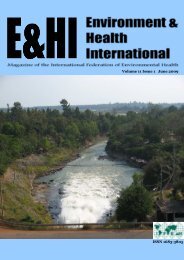IFEH ISSUE 6 - International Federation of Environmental Health
IFEH ISSUE 6 - International Federation of Environmental Health
IFEH ISSUE 6 - International Federation of Environmental Health
- No tags were found...
Create successful ePaper yourself
Turn your PDF publications into a flip-book with our unique Google optimized e-Paper software.
So when did it all begin? The St Kilda archipelago, rising to 1397 ft. above sea level at its highest<br />
point, is evidence <strong>of</strong> volcanic activity going back over 60 million years, similar to the formation <strong>of</strong><br />
islands such as Tristan da Cunha and St Helena in the South Atlantic, located on the mid Atlantic ridge<br />
which extends to the Faroe Islands and areas further north towards Iceland and Spitzbergen. There are<br />
still varying degrees <strong>of</strong> activity along this ridge and adjacent hotspots. The Icelandic ash cloud is very<br />
fresh in our memories and this year marks the 50th anniversary <strong>of</strong> the Tristan da Cunha volcano<br />
eruption that resulted in the entire population <strong>of</strong> the world’s most remote island being evacuated, first<br />
<strong>of</strong> all to South Africa and then to the south <strong>of</strong> England where they spent two years before returning to<br />
their home island in 1963. Emergency Planning takes on a different meaning in places like Tristan<br />
from the point <strong>of</strong> view <strong>of</strong> access and communications. However volcanoes do not feature in the<br />
Western Isles Emergency Plan on the assumption that the St Kilda volcano is now well and truly<br />
extinct.<br />
Over the years, researchers have tried to establish the history <strong>of</strong> human occupation on St Kilda.<br />
Archaeologists have discovered evidence <strong>of</strong> Neolithic and Bronze Age activity but the clearest early<br />
evidence <strong>of</strong> man made structures is in the underground dwellings that point to the Iron Age period.<br />
There is also evidence <strong>of</strong> early Christian churches and a Viking period evident from the names given<br />
to some <strong>of</strong> the smaller islands surrounding the larger island <strong>of</strong> Hirta.<br />
The structures we see today on the “Main Street” on St Kilda are a mix <strong>of</strong> early and mid 19th century<br />
dwellings.<br />
Prior to the organisation <strong>of</strong> the island village into sixteen separate holdings, the very basic stone and<br />
thatch dwellings were built very close to each other in clusters. Then, around 1830 there was a move<br />
36



